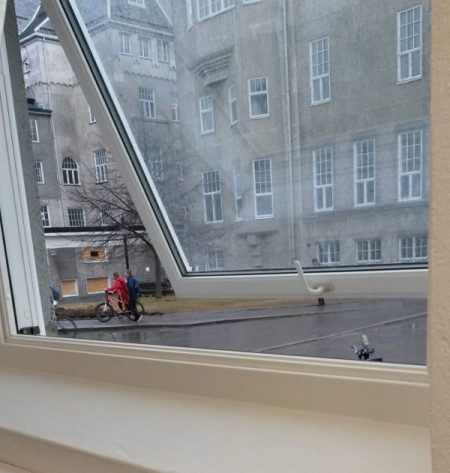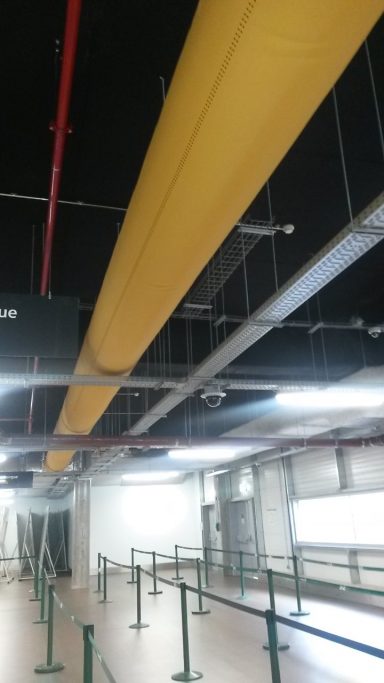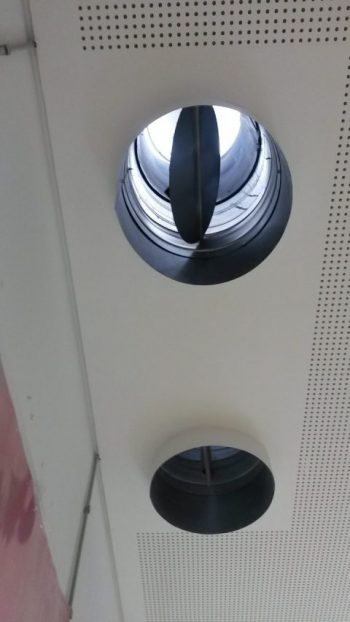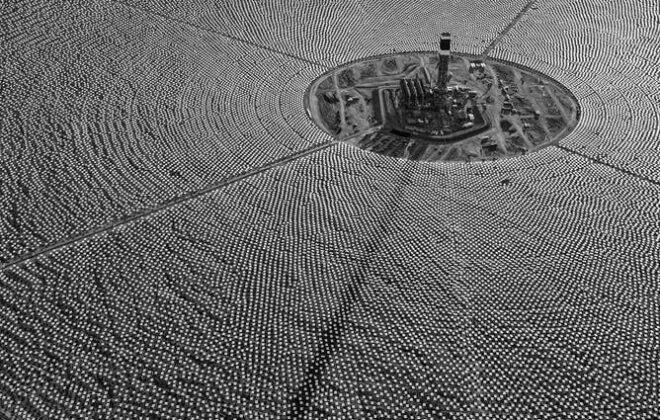Is opening windows the best way to ventilate a building?
That’s a question architects and engineers don’t manage to agree on!
Using windows and openings to ventilate is called natural ventilation in opposition to mechanical ventilation where fans are used to move the air.

Most engineers (“myself included”) feel anxiety when they hear that windows are going to be actively and solely used to provide fresh air, and here are the four most important reasons for their concern:
- When we ventilate a building with an open window, we are exposed to unfiltered air. This air carries particulate matter (aka PM) such as carcinogenic particles from car engines and allergy triggers (pollen, dust, etc). 83 % of the population of the cities, for which PM data exist, are exposed to levels exceeding the air quality guidelines. Mortality from cardiovascular and respiratory diseases and lung cancer are known to be connected to fine particles (PM smaller than 10 μm).
- When we ventilate with an open window, the warm air that is removed from a room leaves the building without allowing for heat recovery. In cold climates, temperature differences be-tween indoor and outdoor air often exceed 30 °C during winter, which means that a lot of en-ergy is needed to warm up the supplied air. Reduced supply of fresh air leads to increased concentrations of many kinds of pollutants indoors. In addition, window-opening procedures are highly dependent on the outdoor weather conditions and cultures. Users will normally open windows during warm periods and leave them closed during cold or windy periods. Over ventilating may yield an increase of energy use and too little ventilation may mean higher concentrations of pollutants, possible mould growth, and high concentrations of CO2, all related to lower performance in offices and health issues.
- When we ventilate with an open window, we hear noise from traffic; or for instance, the school next to your office where kids are playing.
- When we open a window in cold climates, we are exposed to draft. In countries like Norway, an open window during wintertime means an open door to cold draft and complaints.
However, despite all these “facts”, architects keep on talking about natural ventilation as the ultimate solution to provide fresh air to a building. Why do they do that?

- Removing a technical system enables using extra square meters for something else (which satisfies the building owners as they can sell/rent more square meters in the same building). And it avoids meters of ugly piping and noisy technical systems.
- Users that have control over their environment are known to thrive better. Some studies even say that when users can actively control their environment they do it wisely, at home. In general, giving users a high degree of control and freedom of choice eases their adaptation to conditions outside comfort.
The ultimate solution must make users happy
All this proves that architects may not be so wrong when they want to use windows to ventilate.
However, how many times have you been upset with Kari, your office mate, when she opens the window because she is sweating but you are freezing? How many times did you feel it was too warm when you were stressed? What happens when it is not YOU choosing what to do with the window? How many times have you been in a room where the sun shines, you open the window and you feel happy though it is cold outside? The power to change our environment is experienced positively, but how can we ensure that in an open area everyone feel empowered? In addition, not everyone experiences the same comfort in the same conditions. Tolerance limits vary from day to day. There is a social component on our perception of comfort!
So, the answer to the initial question is not really an easy one! Architects, engineers and social scientists should probably talk more to develop solutions that could satisfy everyone. All want to develop the best systems but often fail to see that the best solution has to be interdisciplinary. I have myself discussed many times with natural ventilation enthusiasts and mechanical ventilation heroes.

My proposal is that occupants should have the possibility to control their own environment (windows, blinds, fans) and, automatic mechanical controls should support them to achieve comfortable indoor air quality. Mechanical ventilation should take over when manual control cannot improve the condi-tions and during non-occupied hours. This is called hybrid ventilation. Hybrid means a double invest-ment, but it can be done so that it ensures reduced mechanical ventilation, active use of windows and constant high indoor air quality.
Finally, NO solution is going to work if we don’t have the users on board. We must not forget that the ultimate solution must make users happy, because in the end, it is for users we ventilate. This justifies for me to use the next four years of my life working on my PhD to study and I hope to come up with one best solution.
This blog post was originally posted on www.ntnutechzone.no 24 May, 2018.

Maria Justo Alonso
Maria Justo Alonso is a PhD Candidate at NTNU - Department of Energy and Process Engineering, affiliated with FME ZEN - Research centre on zero-emission neighbourhoods in smart cities.
Tags In
Maria Justo Alonso
Search
Søk
Categories
- Arctic Research
- Arkitektur
- Bærekraft
- Bioingeniørfag
- Biologi
- Biology
- Biomedical Laboratory Science
- Biotechnology
- Bioteknologi
- Chemical Engineering
- Chemistry
- Climate
- Computer Science
- Datateknologi
- Digital
- Elektronikk
- Energi
- Energi
- Energy
- Engineering
- Engineering
- Environment
- Food Science
- Forskning
- Fysikk
- Fysikk
- Havbruk
- Informasjonsteknologi
- Informasjonsteknologi
- Ingeniørvitenskap
- Kjemi
- Kjemisk prosessteknologi
- Kjemisk prosessteknologi
- Kreftbehandling
- Kybernetikk
- Marine Technology
- Materialer
- Materials Science
- Materialteknologi
- Matvitenskap
- Meninger
- Miljø
- Min ph.d.
- My PhD
- My PhD
- My postdoc
- Nanotechnology
- Nanoteknologi
- Ocean
- Oil and gas
- Physics
- Research
- Simulering og visualisering
- Spør en forsker
- Studentliv
- Sustainability
- Ukategorisert
- Universitetsliv
- University Life
Kategorier
- Arctic Research
- Arkitektur
- Bærekraft
- Bioingeniørfag
- Biologi
- Biology
- Biomedical Laboratory Science
- Biotechnology
- Bioteknologi
- Chemical Engineering
- Chemistry
- Climate
- Computer Science
- Datateknologi
- Digital
- Elektronikk
- Energi
- Energi
- Energy
- Engineering
- Engineering
- Environment
- Food Science
- Forskning
- Fysikk
- Fysikk
- Havbruk
- Informasjonsteknologi
- Informasjonsteknologi
- Ingeniørvitenskap
- Kjemi
- Kjemisk prosessteknologi
- Kjemisk prosessteknologi
- Kreftbehandling
- Kybernetikk
- Marine Technology
- Materialer
- Materials Science
- Materialteknologi
- Matvitenskap
- Meninger
- Miljø
- Min ph.d.
- My PhD
- My PhD
- My postdoc
- Nanotechnology
- Nanoteknologi
- Ocean
- Oil and gas
- Physics
- Research
- Simulering og visualisering
- Spør en forsker
- Studentliv
- Sustainability
- Ukategorisert
- Universitetsliv
- University Life



